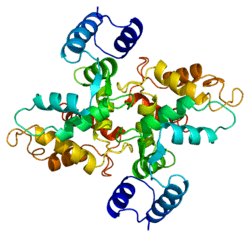Hippocalcin-like protein 1
Hippocalcin-like protein 1 is a protein that in humans is encoded by the HPCAL1 gene.[5][6][7]
The protein encoded by this gene is a member of neuron-specific calcium-binding proteins family found in the retina and brain.[8] It is highly similar to human hippocalcin protein and nearly identical to the rat and mouse hippocalcin like-1 proteins. It may be involved in the calcium-dependent regulation of rhodopsin phosphorylation and may be of relevance for neuronal signalling in the central nervous system. There are two alternatively spliced transcript variants of this gene, with multiple polyadenylation sites.[7]
References
- 1 2 3 GRCh38: Ensembl release 89: ENSG00000115756 - Ensembl, May 2017
- 1 2 3 GRCm38: Ensembl release 89: ENSMUSG00000071379 - Ensembl, May 2017
- ↑ "Human PubMed Reference:".
- ↑ "Mouse PubMed Reference:".
- ↑ Kobayashi M, Takamatsu K, Fujishiro M, Saitoh S, Noguchi T (Aug 1994). "Molecular cloning of a novel calcium-binding protein structurally related to hippocalcin from human brain and chromosomal mapping of its gene". Biochim Biophys Acta. 1222 (3): 515–8. PMID 8038222. doi:10.1016/0167-4889(94)90062-0.
- ↑ Oikawa K, Kimura S, Aoki N, Atsuta Y, Takiyama Y, Nagato T, Yanai M, Kobayashi H, Sato K, Sasajima T, Tateno M (Apr 2004). "Neuronal calcium sensor protein visinin-like protein-3 interacts with microsomal cytochrome b5 in a Ca2+-dependent manner". J Biol Chem. 279 (15): 15142–52. PMID 14739275. doi:10.1074/jbc.M312766200.
- 1 2 "Entrez Gene: HPCAL1 hippocalcin-like 1".
- ↑ Burgoyne RD (2007). "Neuronal Calcium Sensor Proteins: Generating Diversity in Neuronal Ca2+ Signalling". Nat. Rev. Neurosci. 8 (3): 182–193. PMC 1887812
 . PMID 17311005. doi:10.1038/nrn2093.
. PMID 17311005. doi:10.1038/nrn2093.
Further reading
- Hidaka H, Okazaki K (1993). "Neurocalcin family: a novel calcium-binding protein abundant in bovine central nervous system". Neurosci. Res. 16 (2): 73–7. PMID 8387172. doi:10.1016/0168-0102(93)90074-Z.
- Andersson B, Wentland MA, Ricafrente JY, et al. (1996). "A "double adaptor" method for improved shotgun library construction". Anal. Biochem. 236 (1): 107–13. PMID 8619474. doi:10.1006/abio.1996.0138.
- Yu W, Andersson B, Worley KC, et al. (1997). "Large-Scale Concatenation cDNA Sequencing". Genome Res. 7 (4): 353–8. PMC 139146
 . PMID 9110174. doi:10.1101/gr.7.4.353.
. PMID 9110174. doi:10.1101/gr.7.4.353.
- Spilker C, Richter K, Smalla KH, et al. (2000). "The neuronal EF-hand calcium-binding protein visinin-like protein-3 is expressed in cerebellar Purkinje cells and shows a calcium-dependent membrane association". Neuroscience. 96 (1): 121–9. PMID 10683417. doi:10.1016/S0306-4522(99)00536-9.
- Bernstein HG, Baumann B, Danos P, et al. (2000). "Regional and cellular distribution of neural visinin-like protein immunoreactivities (VILIP-1 and VILIP-3) in human brain". J. Neurocytol. 28 (8): 655–62. PMID 10851344. doi:10.1023/A:1007056731551.
- Hartley JL, Temple GF, Brasch MA (2001). "DNA Cloning Using In Vitro Site-Specific Recombination". Genome Res. 10 (11): 1788–95. PMC 310948
 . PMID 11076863. doi:10.1101/gr.143000.
. PMID 11076863. doi:10.1101/gr.143000.
- Braunewell K, Riederer P, Spilker C, et al. (2001). "Abnormal localization of two neuronal calcium sensor proteins, visinin-like proteins (vilips)-1 and -3, in neocortical brain areas of Alzheimer disease patients". Dementia and geriatric cognitive disorders. 12 (2): 110–6. PMID 11173883. doi:10.1159/000051244.
- Ivings L, Pennington SR, Jenkins R, et al. (2002). "Identification of Ca2+-dependent binding partners for the neuronal calcium sensor protein neurocalcin delta: interaction with actin, clathrin and tubulin". Biochem. J. 363 (Pt 3): 599–608. PMC 1222513
 . PMID 11964161. doi:10.1042/0264-6021:3630599.
. PMID 11964161. doi:10.1042/0264-6021:3630599.
- Spilker C, Gundelfinger ED, Braunewell KH (2002). "Evidence for different functional properties of the neuronal calcium sensor proteins VILIP-1 and VILIP-3: from subcellular localization to cellular function". Biochim. Biophys. Acta. 1600 (1–2): 118–27. PMID 12445467. doi:10.1016/s1570-9639(02)00452-1.
- Strausberg RL, Feingold EA, Grouse LH, et al. (2003). "Generation and initial analysis of more than 15,000 full-length human and mouse cDNA sequences". Proc. Natl. Acad. Sci. U.S.A. 99 (26): 16899–903. PMC 139241
 . PMID 12477932. doi:10.1073/pnas.242603899.
. PMID 12477932. doi:10.1073/pnas.242603899.
- Pribanic S, Loffing J, Madjdpour C, et al. (2004). "Expression of visinin-like protein-3 in mouse kidney". Nephron. Physiology. 95 (4): 76–82. PMID 14694264. doi:10.1159/000074844.
- Gerhard DS, Wagner L, Feingold EA, et al. (2004). "The Status, Quality, and Expansion of the NIH Full-Length cDNA Project: The Mammalian Gene Collection (MGC)". Genome Res. 14 (10B): 2121–7. PMC 528928
 . PMID 15489334. doi:10.1101/gr.2596504.
. PMID 15489334. doi:10.1101/gr.2596504.
- Wiemann S, Arlt D, Huber W, et al. (2004). "From ORFeome to Biology: A Functional Genomics Pipeline". Genome Res. 14 (10B): 2136–44. PMC 528930
 . PMID 15489336. doi:10.1101/gr.2576704.
. PMID 15489336. doi:10.1101/gr.2576704.
- Rual JF, Venkatesan K, Hao T, et al. (2005). "Towards a proteome-scale map of the human protein-protein interaction network". Nature. 437 (7062): 1173–8. PMID 16189514. doi:10.1038/nature04209.
- Mehrle A, Rosenfelder H, Schupp I, et al. (2006). "The LIFEdb database in 2006". Nucleic Acids Res. 34 (Database issue): D415–8. PMC 1347501
 . PMID 16381901. doi:10.1093/nar/gkj139.
. PMID 16381901. doi:10.1093/nar/gkj139.
- Jheng FF, Wang L, Lee L, Chang LS (2007). "Functional contribution of Ca2+ and Mg2+ to the intermolecular interaction of visinin-like proteins". Protein J. 25 (4): 250–6. PMID 16703469. doi:10.1007/s10930-006-9008-5.
- Lim J, Hao T, Shaw C, et al. (2006). "A protein-protein interaction network for human inherited ataxias and disorders of Purkinje cell degeneration". Cell. 125 (4): 801–14. PMID 16713569. doi:10.1016/j.cell.2006.03.032.
PDB gallery |
|---|
| 1bjf: CRYSTAL STRUCTURE OF RECOMBINANT BOVINE NEUROCALCIN DELTA AT 2.4 ANGSTROMS |
|
|

 . PMID 17311005. doi:10.1038/nrn2093.
. PMID 17311005. doi:10.1038/nrn2093. . PMID 9110174. doi:10.1101/gr.7.4.353.
. PMID 9110174. doi:10.1101/gr.7.4.353. . PMID 11076863. doi:10.1101/gr.143000.
. PMID 11076863. doi:10.1101/gr.143000. . PMID 11964161. doi:10.1042/0264-6021:3630599.
. PMID 11964161. doi:10.1042/0264-6021:3630599. . PMID 12477932. doi:10.1073/pnas.242603899.
. PMID 12477932. doi:10.1073/pnas.242603899. . PMID 15489334. doi:10.1101/gr.2596504.
. PMID 15489334. doi:10.1101/gr.2596504. . PMID 15489336. doi:10.1101/gr.2576704.
. PMID 15489336. doi:10.1101/gr.2576704. . PMID 16381901. doi:10.1093/nar/gkj139.
. PMID 16381901. doi:10.1093/nar/gkj139.





